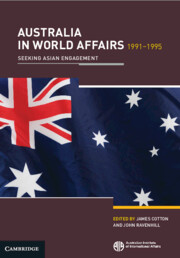310 results
3 - Gender, Migration, and Sexuality in the Modern World
-
-
- Book:
- The Cambridge World History of Sexualities
- Published online:
- 26 April 2024
- Print publication:
- 16 May 2024, pp 50-70
-
- Chapter
- Export citation
1 - Australia in World Affairs 1996–2000
- from Part I - Setting the Scene
-
-
- Book:
- Australia in World Affairs 1996–2000
- Published online:
- 04 May 2024, pp 3-7
-
- Chapter
- Export citation
4 - Australia and Asia: A View From Europe
-
-
- Book:
- Australia in World Affairs 1991–1995
- Published online:
- 04 May 2024, pp 33-43
-
- Chapter
- Export citation
10 - Australia and Southeast Asia
-
-
- Book:
- Australia in World Affairs 1991–1995
- Published online:
- 04 May 2024, pp 108-122
-
- Chapter
- Export citation
15 - Australia and the Global Economy
- from Part III - Issues
-
-
- Book:
- Australia in World Affairs 1996–2000
- Published online:
- 04 May 2024, pp 193-207
-
- Chapter
- Export citation
3 - The Rhetoric of Asia
-
-
- Book:
- Australia in World Affairs 1991–1995
- Published online:
- 04 May 2024, pp 23-32
-
- Chapter
- Export citation

Australia in World Affairs 1991–1995
- Seeking Asian Engagement
-
- Published online:
- 04 May 2024
5 - Australia’s Defence Policies in the Post–Cold War Era
-
-
- Book:
- Australia in World Affairs 1991–1995
- Published online:
- 04 May 2024, pp 44-55
-
- Chapter
- Export citation
7 - Australia and the World Economy 1991–95: Closer Economic Integration with Asia?
-
-
- Book:
- Australia in World Affairs 1991–1995
- Published online:
- 04 May 2024, pp 68-81
-
- Chapter
- Export citation
1 - Australia’s ‘Engagement with Asia’
-
-
- Book:
- Australia in World Affairs 1991–1995
- Published online:
- 04 May 2024, pp 1-11
-
- Chapter
- Export citation
10 - Australia and the United States
- from Part II - Relationships
-
-
- Book:
- Australia in World Affairs 1996–2000
- Published online:
- 04 May 2024, pp 119-134
-
- Chapter
- Export citation
16 - Australia and the Asian Economic Crisis
- from Part III - Issues
-
-
- Book:
- Australia in World Affairs 1996–2000
- Published online:
- 04 May 2024, pp 208-223
-
- Chapter
- Export citation
3 - Balancing ‘Asia’ against Australian Values
- from Part I - Setting the Scene
-
-
- Book:
- Australia in World Affairs 1996–2000
- Published online:
- 04 May 2024, pp 23-36
-
- Chapter
- Export citation
2 - An Overview
-
-
- Book:
- Australia in World Affairs 1991–1995
- Published online:
- 04 May 2024, pp 12-22
-
- Chapter
- Export citation
5 - Hippokrates of Kos (?), Airs, Waters, and Places
- from Part II - Classical Period
-
- Book:
- Geographers of the Ancient Greek World
- Published online:
- 25 March 2024
- Print publication:
- 18 April 2024, pp 157-176
-
- Chapter
- Export citation
Reconstructing Late Neolithic animal management practices at Kangjia, North China, using microfossil analysis of dental calculus
-
- Article
-
- You have access
- Open access
- HTML
- Export citation
14 - Australia and China
- from Part 2 - Australia and the Regions
-
-
- Book:
- Australia in World Affairs 1981–1990
- Published online:
- 29 March 2024, pp 277-299
-
- Chapter
- Export citation
14 - Australia and South-East Asia
- from The Regions
-
-
- Book:
- Australia in World Affairs 1976–1980
- Published online:
- 29 March 2024, pp 223-244
-
- Chapter
- Export citation
12 - Australia and East Asia: Japan
- from The Regions
-
-
- Book:
- Australia in World Affairs 1976–1980
- Published online:
- 29 March 2024, pp 189-206
-
- Chapter
- Export citation
3 - The media and foreign policy
- from Part 1 - Australia and the World
-
-
- Book:
- Australia in World Affairs 1981–1990
- Published online:
- 29 March 2024, pp 51-62
-
- Chapter
- Export citation



